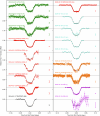A transiting giant planet in orbit around a 0.2-solar-mass host star
- PMID: 40687772
- PMCID: PMC12274134
- DOI: 10.1038/s41550-025-02552-4
A transiting giant planet in orbit around a 0.2-solar-mass host star
Abstract
Planet formation models indicate that the formation of giant planets is substantially harder around low-mass stars due to the scaling of protoplanetary disc masses with stellar mass. The discovery of giant planets orbiting such low-mass stars thus imposes strong constraints on giant planet formation processes. Here we report the discovery of a transiting giant planet orbiting a 0.207 ± 0.011 M ⊙ star. The planet, TOI-6894 b, has a mass and radius of M P = 0.168 ± 0.022 M J (53.4 ± 7.1 M ⊕) and R P = 0.855 ± 0.022 R J and probably includes 12 ± 2 M ⊕ of metals. The discovery of TOI-6894 b highlights the need for a better understanding of giant planet formation mechanisms and the protoplanetary disc environments in which they occur. The extremely deep transits (17% depth) make TOI-6894 b one of the most accessible exoplanetary giants for atmospheric characterization observations, which will be key for fully interpreting the formation history of this notable system and for the study of atmospheric methane chemistry.
Keywords: Exoplanets; Giant planets.
© The Author(s) 2025.
Conflict of interest statement
Competing interestsThe authors declare no competing interests.
Figures











References
-
- Laughlin, G., Bodenheimer, P. & Adams, F. C. The core accretion model predicts few Jovian-mass planets orbiting red dwarfs. Astrophys. J. Lett.612, L73–L76 (2004).
-
- Burn, R. et al. The New Generation Planetary Population Synthesis (NGPPS). IV. Planetary systems around low-mass stars. Astron. Astrophys.656, A72 (2021).
-
- Pascucci, I. et al. A steeper than linear disk mass-stellar mass scaling relation. Astrophys. J.831, 125 (2016).
-
- Manara, C. F. et al. in Protostars and Planets VII (eds Inutsuka, S. et al.) 539–565 (ASP, 2023).
-
- Ida, S. & Lin, D. N. C. Toward a deterministic model of planetary formation. III. Mass distribution of short-period planets around stars of various masses. Astrophys. J.626, 1045–1060 (2005).
LinkOut - more resources
Full Text Sources
